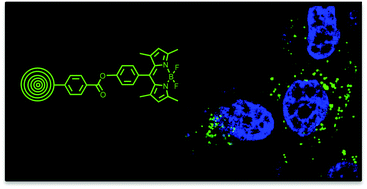Boron dipyrromethene (BODIPY) functionalized carbon nano-onions for high resolution cellular imaging†
Abstract
Carbon nano-onions (CNOs) are an exciting class of carbon nanomaterials, which have recently demonstrated a facile cell-penetration capability. In the present work, highly fluorescent boron dipyrromethene (BODIPY) dyes were covalently attached to the surface of CNOs. The introduction of this new carbon nanomaterial-based imaging platform, made of CNOs and BODIPY fluorophores, allows for the exploration of synergetic effects between the two building blocks and for the elucidation of its performance in biological applications. The high fluorescence intensity exhibited by the functionalized CNOs translates into an excellent in vitro probe for the high resolution imaging of MCF-7 human breast cancer cells. It was also found that the CNOs, internalized by the cells by endocytosis, localized in the lysosomes and did not show any cytotoxic effects. The presented results highlight CNOs as excellent platforms for biological and biomedical studies due to their low toxicity, efficient cellular uptake and low fluorescence quenching of attached probes.


 Please wait while we load your content...
Please wait while we load your content...